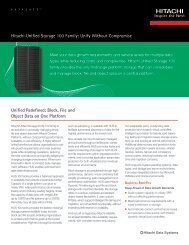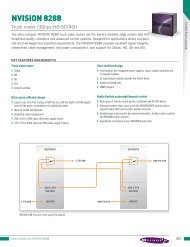Create successful ePaper yourself
Turn your PDF publications into a flip-book with our unique Google optimized e-Paper software.
Broadcast industry’s most <strong>com</strong>prehensivemarket study reveals top trends of 2011Media TrendsBy Joe Zaller, Digital Media Market Strategist at DevoncroftStory reprinted with the permission of Devoncroft PartnersEach year, Devoncroft Partners conducts a large scale globalstudy of the broadcast industry called the Big Broadcast Survey(BBS). More than 8,000 broadcast professionals in 100+ countriesparticipated in the 2011 BBS, making it the most <strong>com</strong>prehensivestudy ever done in the broadcast industry.One of the key outputs is a ranking of the broadcast industrytrends that are considered by BBS respondents to be the most <strong>com</strong>merciallyimportant to their businesses in any given year.To create the 2011 BBS Broadcast Industry Global Trend Index,BBS respondents were presented with a list of 15 industry trendsand asked them to tell us which one trend they consider to be “mostimportant” to their business, which one trend they consider to be“second most important” to their business, and which other trends(plural) they consider to be “also very important.”The responses to these questions was then used to create theBBS Broadcast Industry Global Trend Index by applying a weightingbased on the <strong>com</strong>mercial importance of each trend.The goal is to help clients gain insight into the business driversbehind the respondent’s answer. Therefore, participants were askedthis question in the context of <strong>com</strong>mercial importance, rather than“industry buzz” or technology hype.The table below shows the 2011 BBS Broadcast Industry GlobalTrend Index. This chart measures the responses all non-vendorswho participated in the 2011 BBS, regardless of <strong>com</strong>pany type,<strong>com</strong>pany size, geographic location, job title, etc.Similar to results in both the 2009 and 2010, the top four trendsin the 2011 Global Broadcast Industry Trend Index are: multi-platformcontent delivery, transition to HDTV operations, file-based /tapeless workflows, and IP networking and content deliveryHowever, there has been considerable movement in the relativeranking of these four trends over the past several years. Most significantly,“multi-platform content delivery” has be<strong>com</strong>e increasinglyimportant, and is the dominant trend in 2011. For <strong>com</strong>parison:In 2009, the BBS Broadcast Industry Global Trend Index wasdominated by the transition to HDTV operations, while multi-platformcontent delivery was fourth on the listIn 2010, multi-platform content delivery had be<strong>com</strong>e the mostimportant industry trend, narrowly eclipsing file-based / tapelessworkflows (which were <strong>com</strong>bined in the 2010 BBS Trend Index) andthe transition to HDTV operationsThese results show that broadcast professionals continue tofocus their efforts on taking advantage of the potential for incrementalrevenue streams presented by multi-platform contentdelivery. Indeed, as the chart above shows, multi-platform contentdelivery was ranked significantly higher than any other trend in the2011 study. As video content be<strong>com</strong>e ubiquitous, broadcasters andcontent owners are looking for ways to monetize their assets, andgrow their revenue. Technology vendors are continuing to developsolutions to convert content for optimal performance on any platform,and to run targeted ads alongside that content.But there is more to the story than just multi-platform contentdelivery. For the third year in a row, the transition to HDTV operationsranks as one of the top trends in the broadcast industry. It’slikely that HDTV upgrades will continue to be one of the majordrivers of project-based spending as broadcasters around the worldcontinue with plans to transition their operations to HDTV.Operational efficiencies (through file-based / tapeless workflows)remain a significant macro driver in 2011, as broadcasters continueto deploy new workflows. The increasing importance of file-basedtechnologies has implications for the broadcast industry in terms ofboth workflows and product procurement. Previous research showsthat broadcasters are moving to file-based workflows not only toachieve greater speed and efficiencies, but also to reduce cost.During the recession, technology budgets were typically prioritizedtowards solutions that add revenue and/or reduce cost. Now thatthe industry is recovering from the downturn, it’s likely that theway technology is purchased will remain focused on these<strong>com</strong>mercial priorities.Tracking Changes in Importance of Broadcast IndustryTrends Over Time The transition to HDTV operations, the moveto file-based / tapeless workflows, and IP networking and contentdelivery continue to be important to broadcast professionals.However, they have been outpaced by multi-platform contentdelivery. Since 2009, multi-platform content delivery has gone fromranking #4 in the BBS Broadcast Industry Global Trend Index torunning away with the top spot.Why Tracking Movement of Trends is Important In the broadcastindustry much of the spending on technology is project-based,and those projects all <strong>com</strong>e from somewhere. Our view is that industrytrends drive capital projects, which in turn drive budgets, whichin turn drive product purchase. In other words, what is <strong>com</strong>merciallyimportant to technology buyers today (i.e. trends) will likely turn intowhat they are budgeting for tomorrow (i.e. projects).The 2011 BBS Trend Index shows that monetizing content on multipleplatforms is clearly a key objective for broadcast professionalsin the year ahead. Yet many players, particularly on the contentside, are still experimenting with their business models.There is a difference between recognizing that a trend is<strong>com</strong>mercially important and having a business plan in place that capitalizes on that trend.So while there is no doubt that generating incremental revenue by delivering a multi-screenexperience to consumers is a hot topic, business models have to move beyond the experimentalin order to drive serious market growth.Once that happens, multi-platform content delivery will likely be<strong>com</strong>e the most importantplanned project rather than just the most important trend.Most important technology trends – percentage of respondents When analyzingthis data, it is useful to understand the numbers behind the Index – i.e. the percentageof 2011 BBS respondents who ranked each trend “most important,” “second most important,”and “also very important.”This helps to identify which issues are on the “front burner” versus the “back burner” inthe minds of technology buyers. Front burner issues are more likely to result in budget beingallocated to them. Back burner issues are “also important” but perhaps not enough to justifyexpenditure beyond experimentation.At first glance this table simply reinforces the 2011 BBS Broadcast Industry Global TrendIndex, with many of the trends retaining the same numerical ranking as in the Index.Indeed, the top four trends from the Index (multi-platform content delivery, transitionto HDTV operations, file-based / tapeless workflows, and IP networking and contentdelivery) clearly stand out in terms of their importance to respondents relative to the othertrends on the list. This reinforces the fact that <strong>com</strong>pleting the migration to HDTV, achievingoperational efficiencies, and finding new revenue streams are strong priorities for today’sbroadcast professionals.However it is interesting to note that a large percentage of respondents view improvementsin video <strong>com</strong>pression, video-on-demand, automated workflows, targeted adverting,and 3D as “also very important.”The first three of these four trends have to do with delivering content more efficientlyand generating new revenue streams. The strong showing of 3D in the “also very important”category indicates that broadcast professionals will continue to watch the progress of thistechnology and experiment with it as appropriate for their business models.Improving video <strong>com</strong>pressionIP networkingTapeless workflowTransition to HDMulti-platform deliveryAnalog switch-offCentralised operationsMove to automated workflow3D TVTargeted advertisingVideo on demandThe <strong>Vizrt</strong> Catalogue 2011 13
















![Datasheet [pdf 653.2kb] - DK-Technologies](https://img.yumpu.com/38904183/1/184x260/datasheet-pdf-6532kb-dk-technologies.jpg?quality=85)